NCERT Exemplar Solutions for Class 10 Science Chapter 11 Human Eye and Colourful World
These Solutions are part of NCERT Exemplar Solutions for Class 10 Science. Here we have given NCERT Exemplar Solutions for Class 10 Science Chapter 11 Human Eye and Colourful World
Question 1.
A person cannot see distinctly objects kept beyond 2 m. This defect can be corrected by using a lens of power
(a) +0.5 D
(b) -0.5 D
(c) +0.2 D
(d) -0.2 D
Answer:
(b).
Explanation : Person is suffering from myopia. Focal length of the lens used to correct the defect, f = – d = – 2 m

More Resources
- NCERT Exemplar Solutions for Class 10 Science
- NCERT Solutions for Class 10 Science
- Value Based Questions in Science for Class 10
- HOTS Questions for Class 10 Science
- Previous Year Question Papers for CBSE Class 10 Science
Question 2.
A student sitting on the last bench can read the letters written on the black board but is not able to read the letters written in his test book. Which of the following statements is correct ?
(a) The near point of his eyes has receded away
(b) The near point of his eyes has come closer to him
(c) The far point of his eyes has receded away
(d) The far point of his eyes has come closer to him.
Answer:
(a).
Explanation : Student suffers from hypermetropia. In this case, the near point of the eye recedes away.
Question 3.
A student wants to have third colour from the top corresponds to the colour of the sky after the dispersion of white light through a glass prism. He placed prism ABC with BC as base as shown in figures P, Q, R and S. Which position of the prism is correct ?
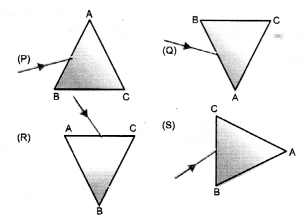
(a) P
(b) Q
(c) R
(d) S.
Answer:
(b).
Explanation : Colour of sky is blue.
Question 4.
At noon, the sun appears white as
(a) light is least scattered
(b) all the colours of the white light are scattered away.
(c) blue colour is scattered the most
(d) red colour is scattered the most
Answer:
(a).
Explanation : At noon, scattering of all colours is almost same.
Question 5.
Which of the following phenomena of light are involved in the formation of a rainbow ?
(a) Reflection, refraction and dispersion
(b) Refraction, dispersion and total internal reflection.
(c) Refraction, dispersion and internal reflection.
(d) Dispersion, scattering and total internal reflection
Answer:
(c).
Explanation : When light falls on a droplet, refraction of light takes place. This refracted light suffers dispersion. Then the light suffer total internal reflection from other surface of the droplet.
Question 6.
Twinkling of stars is due to atmospheric
(a) dispersion of light by water droplets
(b) refraction of light by different layers of varying refractive indices.
(c) scattering of light by dust particles
(d) internal reflection of light by clouds.
Answer:
(b).
Explanation : When sun light enters the earth’s atmosphere, it continuously goes from rarer to the denser medium and hence refraction of light takes place. The refraction of light taking place in the atmosphere is known as atmospheric refraction.
Question 7.
The clear sky appears blue because
(a) blue light gets absorbed in the atmosphere
(b) ultraviolet radiations are absorbed in the atmosphere.
(c) violet and blue lights get scattered more than lights of all other colours by the atmosphere.
(d) light of all other colours is scattered more than the violet and blue colour lights by the atmosphere.
Answer:
(c).
Explanation : Intensity of scattered light, I ∝ 1/λ4 . The wavelength of blue and violet light is smaller than the wavelengths of other colours.
Question 8.
Which of the following statements is correct regarding the propagation of light of different colours of white light in air ?
(a) Red light travels fastest.
(b) Blue light moves faster than green light.
(c) All the colours of white light move with the same speed.
(d) Yellow light moves with the mean speed as that of the red and the violet light.
Answer:
(c).
Explanation : There is no dispersion of white light in air. So all colours travel with the same speed.
Question 9.
The clanger signals installed at the top of tall building are red in colour. These can be seen from a distance because among all other colours, the red light
(a) is scattered the most by smoke or fog
(b) is scattered the least by smoke or fog
(c) is absorbed the most by smoke or fog
(d) moves fastest in air
Answer:
(b).
Explanation : Intensity of scattered light, I ∝ 1/λ4 . Since the wavelengths of red light is greater than the wavelengths of all other lights, therefore, red colour can be seen from a distance.
Question 10.
Which of the following phenomena contributes significantly to the reddish appearance of the sun at sunrise or sunset ?
(a) Dispersion of light
(b) Scattering of light
(c) Total internal reflection of light
(d) Reflection of light from the earth.
Answer:
(b).
Explanation : Intensity of scattered light, I ∝ 1/λ4. Since the wavelength of red light is greater than the wavelengths of all other lights, therefore, red colour is scattered least and confined around the sun.
Question 11.
Water in deep sea is bluish in colour due to
(a) absorption of light by the sea
(b) reflection of sky in water
(c) scattering of light
(d) presence of plants in the sea.
Answer:
(c).
Question 12.
When light rays enter the eye, most of the refraction occurs at the
(a) crystalline lens
(b) outer surface of the cornea
(c) iris
(d) pupil
Answer:
(b).
Question 13.
The focal length of the eye lens increases when eye muscles
(a) are relaxed and lens becomes thinner
(b) contracts and lens becomes thicker
(c) are relaxed and lens becomes thicker
(d) contract and lens becomes thinner
Answer:
(a).
Explanation : Focal length of thin lens is greater than the focal length of thick glass.
Question 14.
Which of the following statement is correct ?
(a) A person with myopia can see distant objects clearly.
(b) A person with hypermetropia can see nearby objects clearly.
(c) A person with myopia can see nearly objects clearly.
(d) A person with hypermetropia cannot see distant objects clearly.
Answer:
(c).
Explanation : Hypermetropia : A person suffering from this defect can see far off objects clearly but cannot see nearby objects clearly.
Myopia : A person suffering from this defect can see nearby objects clearly but cannot see far off objects clearly.
Question 15.
Draw ray diagrams each showing
(i) myopic eye and
(ii) hypermetropic eye.
Answer:
(i)

(ii)

Question 16.
A student sitting at the back of the classroom cannot read clearly the letters written on the black board. What advice will a doctor give to her ? Draw ray diagram for the correction of this defect.
Answer:
Doctor will advice the student to wear spectacles havi ng con¬cave lens of suitable focal length or power as she is suffering from myopia.
For diagram,
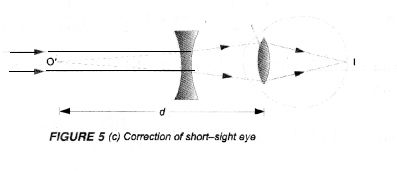
Question 17.
How are we able to see nearby and also the distant objects clearly? (CBSE 2012)
Answer:
Human eye is able to see nearby and also the distant objects clearly using its power of accommodation.
Question 18.
A person needs a lens of power -4.5 D for correction of her vision.
(a) What kind of defect is she suffering from ?
(b) What is the focal length of the corrective lens ?
(c) What is the nature of the corrective lens ?
(CBSE Sample Paper 2017-18)
Answer:
(a) She is suffering from myopia
![]()
(c) Concave lens.
Question 19.
How will you use two identical prisms so that a narrow beam of white light incident on one prism emerges out of the sec¬ond prism as white light ? Draw the diagram.
Answer:
Perform an activity to show that the colours of white light splitted by a glass prism can be recombined to get white light by another glass prism.
Apparatus required. Two glass prisms made of same kind of glass, a card board having a fine hole at its centre, a white screen.
Procedure:
- Place a card board in front of a prism A. A ray of white light coming from the hole in the card board falls on the prism A (Figure 11).

- White light splits into seven colours by prism A is made to fall on another glass prism B placed with its base upward. Since prism A disperses white light, so it is known as dispersing prism.
- The prism B deviates colours of light towards its base. The various colours recombines at the opposite lace of glass prism B.
- This activity was initially performed by the great scientist Issac Newton.
The light received on the white screen placed in front of prism B is white. Since the prism B recombines the colours of light to produce white light, so glass prism B is known as recombination prism.
Question 20.
Draw a ray diagram showing the dispersion through a prism when a narrow beam of white light is incident on one of its refracting surfaces. Also indicate the order of the colours of the spectrum obtained.
Answer:
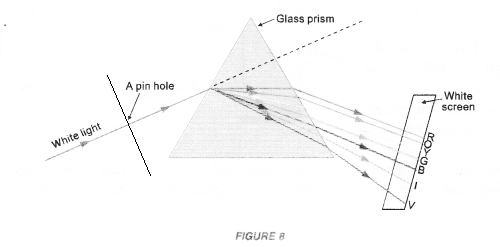
Question 21.
Is the position of a star as seen by us its true position. Justify your answer.
Answer:
No.
Light emitted by distant stars (act as point sources of light) passes through the atmosphere of the earth before reaching our eyes. The atmosphere of the earth is not uniform but consists of many layers of different densities. The layers close to the surface of the earth are optically denser. As we go higher and higher, the density of layers and refractive index decreases progressively. As the light from a star enters the uppermost layer of the atmosphere, it bends towards the normal as it enters the next layer. This process continues till the light enters our eyes. So due to refraction of light, the apparent position of the star is different from the actual position of the star (Figure 13).
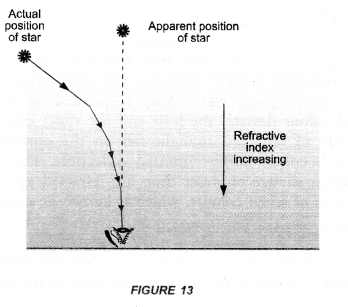
Question 22.
Why do we see a rainbow in the sky only after rainfall ?
Answer:
Rainbow is the example of dispersion of sunlight. In sky, prism like objects are needed for the dispersion of light. After rainfall, tiny water drops suspended in air act as prisms. Hence, we see a rainbow in the sky only after rainfall.
Question 23.
Why is the colour of clear sky blue ?
Answer:
When sunlight enters the earth’s atmosphere, the atoms or molecules of the gases present in the atmosphere scatter this light. Since wavelength of red colour is larger than the wavelengths of other colours in sunlight, so red colour is scattered least. Violet colour is scattered the most followed by blue, green, yellow, orange and red colours respectively. Our eye is more sensitive to the blue light than the violet light. Therefore, scattered light in the sky contains blue colour in plenty and hence the clear sky appears blue.
Note : Sky appears greyish over cities having industrial units. The smoke and dust particles in the atmosphere over such cities scatter red, orange and yellow colours more than other colours of small wavelengths. Hence, the sky appears greyish.
Question 24.
What is the difference in colours of the sun observed during sunrise/sunset and noon ? Give explanation for each.
Answer:
At the time of sunrise or sunset, the position of the sun is very far away from us (Figure 16).
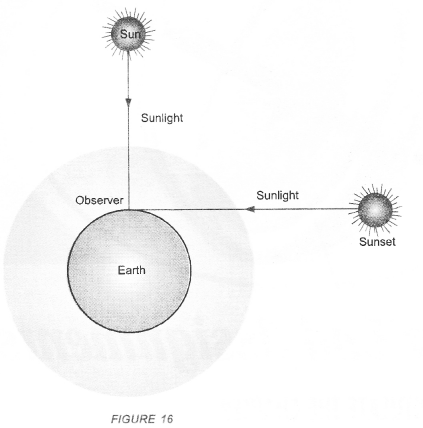
The sunlight travels longer distance through the atmosphere of the earth before reaching our eyes. Scattering of blue light is more than the scattering of red light. As a result of this, more red light reaches our eyes than any other colour. Hence sunset and sunrise appear red.
During noon, the sun is overhead and sunlight travels less distance through the earth’s atmosphere to reach our eyes. In this case, the scattering of almost all colours is very small. Hence, the sun appears white.
Hope given NCERT Exemplar Solutions for Class 10 Science Chapter 11 Human Eye and Colourful World are helpful to complete your science homework.
If you have any doubts, please comment below. Learn Insta try to provide online science tutoring for you.